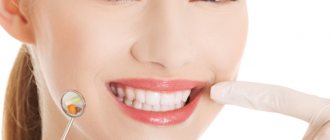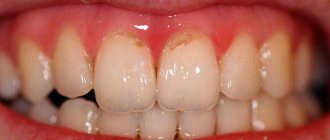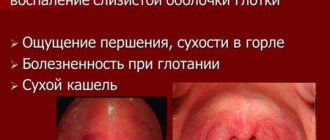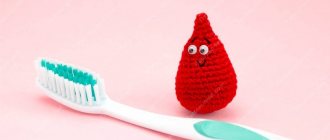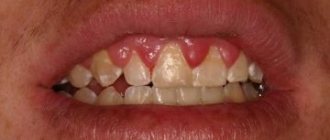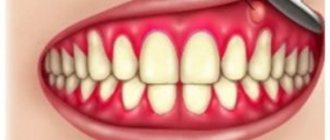Author: Brodsky Sergey Evgenievich Deputy Chief Physician, Candidate of Medical Sciences in the specialties: dentistry and medical microbiology Gums are weak and bleed - this problem affects a large number of people of different ages, even those who regularly and efficiently take care of their teeth, but forget to strengthen them gums. Gum tissue is a barrier that protects the alveolar processes of the jaws, which support teeth, from damage and microbes.
- Causes of gum disease
- Therapeutic measures to strengthen gums
- Dental Solution to Weak Gums
- Drug treatment
- Strengthening gums with folk remedies
- Changing your diet for bleeding gums
Deputy Chief physician Sergey Evgenievich Brodsky
Sign up for a free consultation
+7
Causes associated with dental diseases
The cause of loose teeth in the gums can be various dental diseases, such as periodontitis, periodontal disease, periodontitis and gingivitis. Incorrect bite can also trigger the appearance of this disease.
With gingivitis, many bacteria live in the oral cavity, which cause bleeding gums and, as a result, loosening of teeth.
With periodontitis, the same symptoms are present, but they are also accompanied by bad breath and inflammatory processes in the gums begin. The cause of both diseases is poor oral hygiene.
Periodontal disease is not associated with inflammatory processes and is accompanied by a decrease in the bone walls between all teeth, resulting in bleeding and itching in the gums, and the teeth become mobile and their sensitivity increases.
What is the danger of the disease
Bleeding gums may indicate the presence or increased likelihood of oral disease. The waste products of microorganisms are toxic, but with regular hygiene measures their quantity does not harm the gums. In the absence of oral care, their concentration increases and plaque appears on the teeth. As a result, inflammatory processes are formed, and plaque eventually turns into stone, which puts pressure on the gum, destroying its base. Inflammation of bone tissue can lead to tooth loss (edentia).
Regular bleeding can be a clear symptom of a serious pathology (for example, a bleeding disorder). In the absence of long-term treatment, painful microorganisms that are localized in the oral cavity can enter the bloodstream, which will lead to a number of problems. Among the most common complications:
- gastrointestinal disorder;
- damage to the pancreas by a malignant tumor;
- increased risk of stroke.
Causes of disease not related to gum disease
Dental disease is not the only factor that causes loose teeth. This process can occur for a number of other reasons:
- As a result of genetic predisposition to the disease.
- Weakening of the immune system.
- Diabetes.
- Hormonal imbalances.
- Psoriasis.
- Trauma to the maxillofacial area.
- Arthritis.
Only a dentist can correctly determine the cause of the disease. If the teeth are loosened as a result of a strong blow, the doctor sends the patient for an x-ray for a more detailed diagnosis, and then decides on subsequent treatment. If the cause is a chronic disease, the doctor will prescribe dental procedures or prescribe the appropriate medication to strengthen the gums.
Therapeutic measures to strengthen gums
How to strengthen gums with periodontal disease and periodontitis? It is quite possible to completely cure pathological processes and get rid of loose gum tissue even in advanced cases. To do this, complex therapy is carried out, combining surgical, medicinal and alternative treatment, supplemented by nutritional correction. Treatment and strengthening of gums in dentistry will show good results only if they are performed in a specialized clinic that has a high national rating.
Dentistry "Partner-Med", according to a large number of patients, is best suited for such treatment. The advantages of our clinic are:
- Pre-treatment consultation is always free of charge.
- Qualified specialists with extensive experience are guaranteed to solve even the most complex dental problem.
- The patient has the opportunity to choose from several services that are suitable for him, the one that is more affordable, which allows him not to overpay for treatment.
Diet and vitamins
Proper, balanced nutrition is necessary for gum health. To strengthen the mucous membranes and blood vessels, you need to eat foods high in vitamin C, such as citrus fruits and green leafy vegetables. Vitamin K, found in large quantities in green vegetables and herbs, has a similar effect. Antioxidants and tannins contained in green tea and red wine have an anti-inflammatory and healing effect, slowing down the aging process. In addition, it is important to consume enough phosphorus, calcium and zinc - they are contained in seafood, garlic and onions, and dairy products.
Vitamin complexes are well suited as an additional source of nutrients - in particular, the vitamin-mineral complex for teeth ASEPTA. It contains vitamins A, B3 and B6, C, D3, as well as coral calcium and green tea extract. In addition, coenzyme Q10, which is contained in the complex, has a powerful regenerating effect and restores damaged gum tissue.
Weak gums: clinic
Depending on the cause that led to the weakness of the gums, the patient is monitored for a certain clinical picture:
- Bleeding gums.
- Swelling.
- Redness.
These symptoms are typical of gingivitis, the mildest form of gum inflammation. This disease is easy to treat and rarely causes complications if the patient consults a specialist in a timely manner. Otherwise, it progresses and leads to the development of periodontitis, which has more pronounced symptoms:
- Detachment of gums.
- Formation of periodontal pockets.
- Destruction of bone tissue.
- Violation of the integrity of the dentogingival junction.
- Mobility of teeth.
- Formation of cysts with purulent contents.
With periodontitis, weakness and looseness of the gums can be eliminated relatively quickly, but more serious manifestations of the disease will require long-term and complex treatment.
Folk remedies for treating illness
Regular rinsing of the mouth with special solutions or decoctions of medicinal plants is an excellent remedy for strengthening the gums. For this purpose, you can use decoctions of oak bark, eggplant peel, and horseradish. The most popular herbs for strengthening gums are chamomile, sage, St. John's wort, mint, and burdock.
Four folk recipes for rinsing to strengthen gums:
- Tea tree oil is an effective remedy for strengthening weak gums due to its ability to heal wounds and fight bacteria. To prepare a solution that needs to be used to rinse the mouth, take 2 drops of oil and half a glass of clean water.
- One of the popular folk recipes is a tincture made from a mixture of linden blossom and oak bark in equal proportions. To prepare it, just take a teaspoon of each component and pour 2 cups of boiling water over them. You should rinse your mouth with the resulting product after each meal.
- You can disinfect the oral cavity with cognac. To do this, you need to rinse it with a small amount of drink.
- Burdock decoction. The product should be used at least twice a day. To prepare it, you need to boil a tablespoon of the herb in 500 milliliters of water, then cool and strain through cheesecloth or a sieve.
To strengthen the gums and teeth, it is recommended to massage with the thumb and forefinger. The gums are treated with vertical massaging movements - from one tooth to another. Each section should be worked for 20 seconds. To increase efficiency, you can carry out the procedure by first dipping your fingers in honey or tea tree oil.
To strengthen the gums, it is recommended to use lotions:
- Plantain juice helps a lot. A cotton or gauze swab is moistened in it and applied to the gum.
- A decoction of young pine needles. To prepare the lotion, you need to boil 3 tablespoons of needles in 200 milliliters of water for 10 minutes. After this, the product is infused for at least 7 hours. A cotton swab dipped in the broth is applied to the sore gums.
Comments
Hello! Which doctor should you consult to solve the problem of bleeding gums?
Klaus (01/16/2020 at 01:59) Reply to comment
- Hello! First of all, you need to contact a regular dentist or dental hygienist. These doctors will diagnose the condition of the oral cavity and professional hygiene. However, if it turns out that you have periodontitis, it is advisable that your observation and treatment be carried out directly by a specialist such as a periodontist.
Editorial staff of the portal UltraSmile.ru (01/20/2020 at 09:10) Reply to comment
Write your comment Cancel reply
Ointments and gels
The main advantage of gels and ointments compared to rinses is their ability to remain longer on the surface of the gum mucosa - and, as a result, provide a therapeutic effect for a longer time. ASEPTA healing gel contains propolis, a component of natural origin that has antibacterial, anti-inflammatory and regenerating effects. Thanks to this, the gel, when used regularly, can eliminate almost all the unpleasant symptoms that accompany weakening gums, as well as have a positive effect on the condition of the tissues themselves. The product is applied twice a day to the affected areas (necessarily after thorough brushing of the teeth). After using it, do not consume food or liquid for half an hour. This gel allows you to quickly strengthen your gums at home.
An equally effective remedy is the adhesive balm ASEPTA. The sticky pectin base prevents saliva from washing off the balm from the surface of the mucous membrane - its antimicrobial effect lasts more than half an hour. The balm contains powerful antiseptic components - chlorhexidine and metronidazole, which can prevent the development of inflammatory gum diseases - gingivitis and periodontitis.
Methods for treating bleeding gums
Curettage
Curettage is the surgical cleaning of a periodontal pocket. Curettage differs from professional dental cleaning in that in addition to plaque and subgingival stones, affected soft periodontal tissues must also be removed. There are two types of curettage.
- Closed.
If the pockets are not deep, then the operation takes place without making a gum incision. - Open.
If the pocket depth exceeds 4 mm, then the operation begins with a gum incision under local anesthesia. In most cases, this technique is resorted to if the previously performed closed curettage did not give the expected effect.
Plasmolifting
Plasmolifting is a method of treating periodontal tissues using injections of the patient’s autoplasma. The procedure is extremely simple: 10 ml of blood is taken from the patient, plasma is separated from it by centrifugation, and then it is injected into the problem gum. Due to the fact that plasma is rich in platelets, enzymes and proteins, after administration it serves as a catalyst for cell renewal at the site of damage. Plasmolifting has a number of undeniable advantages.
- Safety.
Since we are talking about the patient’s own blood, the problem of biological compatibility is excluded. - Efficiency.
The duration of the procedure is 10–15 minutes, and the result is noticeable within 1–2 days. - Regeneration.
The healing process takes place in a short time, and the procedure itself does not cause pain. - Favorable prognosis.
A high percentage of effectiveness provided that the procedure is regularly repeated once every 3 months.
Vector
The Vector device is a modern German device that, using ultrasound, painlessly destroys plaque and tartar, cleans periodontal pockets of purulent contents and polishes teeth with a special suspension based on calcium hydroxyapatite. Refers to conservative methods of treatment. Allows you to clean at a depth that was previously inaccessible without surgical intervention. The procedure does not require anesthesia, and when used systematically, it prevents the re-development of inflammatory periodontal diseases. However, there are also contraindications for using the Vector device:
- first half of pregnancy;
- installed pacemaker;
- oncology;
- previous organ transplantation;
- problems with blood clotting.
Gum plastic surgery
Gum grafting (or, as dentists call it, gingivoplasty) is a surgical technique used for severe periodontitis, which is characterized by very deep pockets. With the help of gingivoplasty, it is possible to excise excess gum tissue or, on the contrary, to build it up if there is a deficiency of it, leading to loosening of the teeth. The operation is low-traumatic and is performed under local anesthesia with anesthetics. The process takes place in 4 stages.
- A horizontal incision is made in the gums, followed by removal of a flap of damaged tissue (which is why such a surgical intervention is often called “flap surgery”).
- The gum tissue is then separated from the tooth without removing it.
- The contents of periodontal pockets are evacuated, followed by polishing of the tooth roots.
- The gum tissue is “put back” into place and sutures are placed to secure it in place.
Provided you regularly rinse your mouth with antiseptics and follow a gentle diet, the rehabilitation process after gum surgery will not take much time.
Toothpaste for strengthening gums
Therapeutic and prophylactic toothpastes are also an excellent tool for combating looseness of gingival tissue. Proper brushing of teeth is effective in itself - by massaging the gums with a brush, we improve blood circulation in the tissues and remove plaque, which is a constant source of infectious danger. In addition, many pastes contain antiseptic components that kill pathogens. However, it should be remembered that such pastes cannot be used for a long time, as this may negatively affect the state of the natural microflora of the teeth.
For regular use, pastes based on natural ingredients are better suited. For example, ASEPTA and ASEPTA Sensitive toothpastes contain extracts of calendula, sage, St. John's wort, sweet clover, calamus and other medicinal plants that relieve inflammation, eliminate bleeding and have a mild antiseptic effect. ASEPTA Sensitive paste also contains minerals - potassium citrate and hydroxyapatite, which increase the resistance of teeth to caries.
Treatment with drugs
Drug treatment for bleeding gums is carried out in most situations, and in the early stages of inflammation this is sufficient. For periodontal diseases provoked by an inflammatory process, two types of conservative therapy are used.
- Anti-inflammatory therapy. The most popular products are Cholisal, Metrogyl Denta and Parodontocid gels, which are used in conjunction with rinses containing chlorhexidine. Modern products contain aluminum lactate, which effectively copes with bleeding gums.
- Antibiotic therapy. Used to combat pathogenic microflora. The most common antibiotics for treating gum inflammation are Amoxiclav, Metronidazole, Ciprofloxacin and Tetracycline.
During the treatment process, the doctor usually prescribes medicated toothpastes, as well as a complex of vitamins that help restore oral tissues.
How to strengthen teeth and gums? Basic recommendations
List of recommendations for strengthening gums:
- Use special toothpastes.
- Introduce dairy products into your diet, as well as foods containing large amounts of vitamin D.
- Use rinse aids.
- Use floss to clean teeth in hard-to-reach areas.
- See your dentist regularly to check the condition of your teeth and gums.
See your dentist regularly to check the condition of your teeth and gums.
Prevention of bleeding
Anyone who has at least once experienced bleeding when brushing their teeth knows how scary it is to see scarlet drops on the surface of a white sink. To avoid these troubles in the future, remember a few useful tips.
- Take care of your oral cavity
. Take the time to brush your teeth thoroughly twice a day. Try to rinse your mouth every time after eating, be sure to use dental floss, and change your brushes every 2-3 months. - Eat right
. Remember, even if you feel great drinking a cup of espresso for breakfast, lunch and dinner, even if cigarettes and wine make you feel great, your teeth suffer from such a diet. Pay attention to your diet: diversify your dishes with fresh vegetables and fruits, consume enough dairy and fermented milk products, and do not forget about protein foods. Remember, everything in the body is interconnected, take care of yourself. - Visit your dentist regularly
. No matter how difficult and busy your everyday life may be, find time to make an appointment with a doctor. It is enough to visit a dentist-therapist twice a year: the doctor will assess the condition of the teeth and gums, if necessary, prescribe professional cleaning and cure the resulting caries.
Consumer Reviews
Kotty about Asepta adhesive gum balm (otzovik.com)
“I had to purchase this adhesive balm because the dentist diagnosed me with periodontal disease. Therefore, when I have gum inflammation, I use this drug in courses every 6 months. I must note that the drug very quickly exerts its healing effect on the gums. The pain goes away immediately after starting treatment.
The dentist recommended that I lubricate my gums at night, once a day for 7 days.
Having studied the composition, I saw there such a substance as metronidazole and chlorhexidine. I realized that metronidazole is still an antibiotic. But since I was prescribed this medicine, I was calm. Although, frequent use of substances such as chlorhexidine and metronidazole on the skin and mucous membranes is undesirable, because the protective properties that the mucous membrane and skin should produce may cease to be produced. The dentist told me this too. Therefore, it is very important to use such products only for their intended purpose and strictly according to the instructions.
Of the indicated effects of the balm on the gums, the following were indicated:
- pronounced antibacterial effect on the gums;
- relieving inflammation and bleeding gums;
- breath freshening.
The package also contained a special plastic spatula, which was used to apply the balm to the gums. I must say that it is very comfortable. The balm itself is very thick and hardens after application. But the taste is generally tolerable.
I am satisfied with the effect of the balm. Good quality. It's not that expensive, considering that it lasts a long time. I recommend".
Minuto4ka about Asepta mouthwash (otzovik.com)
“Mint is an acquired taste, in everything. For example, I can completely tolerate it and love it. But I know a lot of people who can’t stand tongue-biting additives.
These are the first associations that arose for me when I first used this mouthwash.
It is sweet and has a lime flavor. And absolutely non-biting.
They prescribed it to me for absolutely no reason, of course.
My dentist prescribed it for me. For gums, which really bother me due to the periodic eruption of wisdom teeth. Which I'm terrified of deleting.
The rinse aid is sold in pharmacies, I haven’t seen it in supermarkets, which captivates me. I would like to believe that it is truly therapeutic in nature. They prescribed me this mouthwash along with Asepta dental gel. I don’t know which of them helped in the end. Maybe all together.
I think the advantage of the bottle is the presence of a measuring cup. It is very comfortable. Not all mouthwashes have it...
... overall I recommend it. At least it will win over its audience with its taste.”
Sources:
- Study of the clinical effectiveness of the use of therapeutic and prophylactic agents of the ASEPTA series in the treatment of inflammatory periodontal diseases in children and adolescents (I.V. Klimova) Irina Vladimirovna Klimova, Candidate of Medical Sciences, Associate Professor of the Department of Pediatric Dentistry, Novosibirsk State Medical University. Department of Pediatric Dentistry, Novosibirsk State Medical University.
- Clinical studies of antisensitive toothpaste “Asepta Sensitive” (A.A. Leontyev, O.V. Kalinina, S.B. Ulitovsky) A.A. LEONTIEV, dentist O.V. KALININA, dentist S.B. ULITOVSKY, Doctor of Medical Sciences, Prof. Department of Therapeutic Dentistry, St. Petersburg State Medical University named after. acad. I.P. Pavlova
- Report on clinical trials to determine/confirm the preventive properties of commercially produced personal oral hygiene products: mouth rinse "ASEPTA PARODONTAL" - Solution for irrigator." Doctor of Medical Sciences Professor, Honored Doctor of the Russian Federation, Head. Department of Preventive Dentistry S.B. Ulitovsky, doctor-researcher A.A. Leontiev First St. Petersburg State Medical University named after academician I.P. Pavlova, Department of Preventive Dentistry.
- The role of anti-inflammatory rinse in the treatment of periodontal diseases (L.Yu. Orekhova, A.A. Leontyev, S.B. Ulitovsky) L.Yu. OREKHOVA, Doctor of Medical Sciences, Prof., Head of Department; A.A. LEONTIEV, dentist; S.B. ULITOVSKY, Doctor of Medical Sciences, Prof. Department of Therapeutic Dentistry of St. Petersburg State Medical University named after. acad. I. P. Pavlova
Methods for treating bleeding gums
Below is a table that shows the most common clinical cases and describes possible methods for treating inflammation and bleeding gums.
What to do if they are bleeding and inflamed
During the inflammatory process, the most important thing is to clean dental plaque and follow-up therapy, including antibiotics. In the most difficult cases, the doctor resorts to surgical manipulations to effectively clean periodontal pockets.
What to do if your gums bleed very badly
Most often, severe gum bleeding occurs after injuries and surgical procedures. In this case, it is necessary to apply stitches and restore the shape and structure of the soft tissues. In case of serious damage (including due to inflammation), gum grafting may be required.
What to do if your gums bleed when brushing your teeth
This can happen for two reasons: a toothbrush that is too hard or an inflammatory process, which increases the fragility of the capillaries and thins the epithelial layer. An additional factor in gum bleeding when brushing teeth can be diseases, in particular leukemia, HIV and diabetes. In the first case, you need to change your toothbrush and use soft tissue strengtheners. In the presence of an inflammatory process, antibiotics and anti-inflammatory drugs are required, as well as removal of dental plaque.
What to do if the gums under the crown are bleeding
This happens due to incorrect installation, errors in calculations during the manufacture of an orthopedic product, as well as damage to the prosthesis. In this case, it is necessary to replace the crown and treat the gums with anti-inflammatory and antiseptic drugs. If pulpitis or periodontitis has developed, purulent abscesses may form on the gums. This requires surgical intervention coupled with therapeutic and endodontic treatment.
